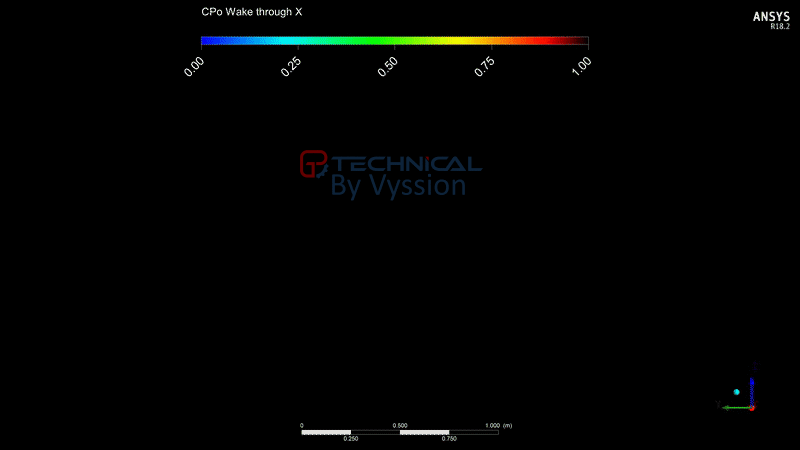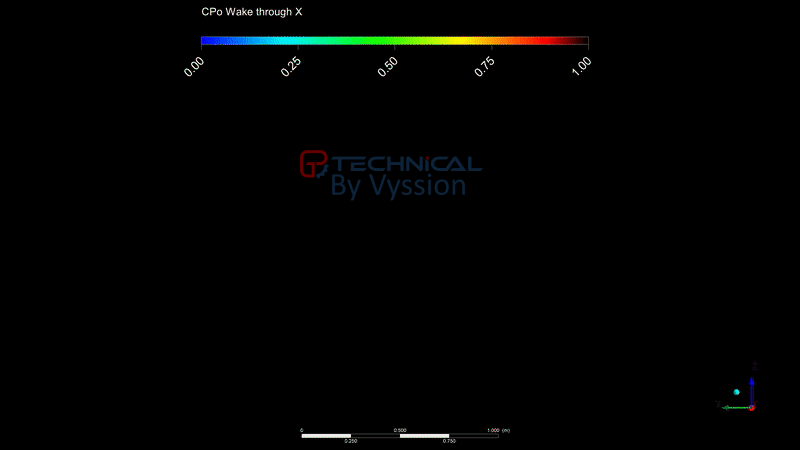CFD Analysis of 2021 Rules
F1technical take a look at the aerodynamics of an F1 car designed to the 2021 regulations as compared to the modified Perrin F1 model used in previous studies.

Getting the boring stuff out of the way, this study was performed using Ansys CFX with a RANS solver and a k-omegaSST turbulence model. The car was set to a ride height of 5mm as measured on the reference plane at the front axle and 93mm at the rear axle (a rake angle of 1.4°). The wind speed was set at 50m/s (180km/hr) and for this first baseline case no sideslip was set, though future runs will feature a small cross-wind angle or curved flow to imitate a cornering manoeuvre. The mesh contained approximately 32 million cells for the full car model and, as with previous studies using our adapted Perrin model, the car features no internal flow to help keep the mesh count down; with the air exiting the sidepod inlets and being reintroduced at the back of the car. The cell count achieved is about 1/5th of what F1 teams will be running however, as the simulation was run on a (good but not great) home PC we are compromised by computing power - absolute accuracy of results should be taken with a pinch of salt!
Downforce achieved for the 2021 car was slightly higher than anticipated for a first case, comparing quite favourably to an approximate average value for a 2019/20 car - within 10%. The aerodynamic balance is 49.6% on the front axle though, i.e. tending toward oversteer, so future runs will need to work on dialing back the front wing downforce to try and achieve a more neutral handling (~40% front considering the fixed COG rule); as well as fixing some flow issues further down the car - more on that later. Drag produced by the car is considerably higher than a good 2019 car (dCx = 0.31 which is bigger than the drag coefficient for a normal family car). Using a simple equivalence that each point (Cx = 0.01) of drag is worth ~0.06s of lap-time the higher aerodynamic drag for this car would cause an increase in average time by ~1.86s/lap, while the lower downforce would add some 1.17s/lap (again these numbers are just for this car). Part of this drag increase can be explained by the larger diameter tyres, 725mm rather than 670mm, while there is also a fairly substantial increase in drag from the longer and wider rear wing, relative to a 2019/20 car. Contrary to popular opinion the venturi floor is not drag free, nor is it producing the majority of downforce. However, it should be noted the force from the front fences is included with the 2021 floor where the 2019/20 bargeboards are not, there is also some flow separation on the top edge of the tunnel entry which will be spoiling performance.
Key component aerodynamic coefficients.
| Lift | Drag | Total | Front Wing | Rear Wing | Floor |
| 2019/20 approximate | -3.75 | 0.90 | -0.94 | 0.18 | -0.75 | 0.26 | -2.06 | 0.13 |
| 2021 f1technical model | -3.36 | 1.21 | -1.24 | 0.11 | -0.85 | 0.35 | -1.69 | 0.23 |
Looking at the distribution of downforce it’s clear the front wing is over producing, which is robbing some performance from the floor as well as reducing the contribution of the floor as a percentage of the total downforce. For comparison it would be expected that for a typical modern F1 car the floor is producing ~55% of downforce, the front wing ~25%, and the rear wing ~20%. Total downforce and the contribution of the floor could be improved depending on the car attitude; i.e. producing an aero-map, which if we were working to properly develop this car would be the priority for a future study.

Surface pressure distributions are a means of visualizing how hard a particular area of the car is working aerodynamically. This can be non-dimensionalised into what we call “Coefficient of Pressure” (or CP); essentially, allowing us to compare across different CFD cases. Colder colours tend to show a “pulling” (or suction) force, whilst the hotter colours show a “pushing” force. It is therefore easy to see how lower pressures on the underside, suck the car onto the track surface, whilst higher pressures on the topside, push the car down onto the track. The pressure distribution of the floor is reversed from a 2019/20 style car, with the greatest and largest region of suction generated towards the centre of the wheelbase, with a comparatively small low pressure spike at the diffuser kick. This is by design as the floor contributes to the balance shift experienced in another cars wake - shifting the centre-of-pressure to the middle of the floor should reduce the understeer effect when following another car, which should in turn help reduce some of the tyre overheating issues experienced over the past few seasons. The underside also shows a lower pressure along a greater area of the floor than our previous runs - it should be noted the Perrin used in earlier studies makes significantly less downforce compared to a genuine F1 car, and that the performance of the floor was made worse by successive studies investigating the 2019 front wing changes (turns out just plonking on a different wing not designed for a particular car isn’t very good) as noted in earlier articles. The attitude chosen for the 2021 car also has the rear axle relatively high in the air, so it’s possible more rear underbody downforce could be extracted by using a flatter rake angle, but this would move the front wing further out of ground effect.


 Comparison of underside pressure contours for 2018 (top), 2019v2 (middle), and 2021 (bottom) cars.
Comparison of underside pressure contours for 2018 (top), 2019v2 (middle), and 2021 (bottom) cars.
The top surface is less dramatically different as the top bodywork is principally similar to current cars. The front wing sweeping up (anhedral) to join the nose cone extends the high pressure field from the wing over the top of the nose, while the flatter curve of the top of the monocoque removes the low pressure kink where teams have their S-duct outlets. The front wheel arch winglets produce some lift which creates downwash to reduce the size of the large and highly turbulent separation wake behind the wheels. The rear wing endplate redesign creates a region of low pressure on the outer, curved face of the wing tip, reducing the pressure on the top surface of the wing elements towards the tips.

 Comparison of upper surface pressure contours for 2019v2 (top) and 2021 (bottom) cars.
Comparison of upper surface pressure contours for 2019v2 (top) and 2021 (bottom) cars.
As the purpose of this rule change is to affect the shape of the wake to be less detrimental to the aerodynamics of a following car it makes sense to look at the wake. From the front of the car the wake of the front wing is “cleaner” than the current spec cars, as the loss of the Y250, underside strakes, and chassis vanes means there is relatively little flow disturbance under the chassis and into the floor tunnels. The upwash from the front wing wake is stalling the upper suspension arms and the leading edge of the floor, adding drag and creating a thicker wake - reducing the front wing camber should help solve this as well as the balance issue. The front tyre wake is more complex with the vorticity from the wheel arch and front wing endplate mixing the flow. Under the tunnel the front fences have two functions, to outwash the front tyre wake so that it does not affect downforce, and to produce a vortex which runs up the tunnel and infers a low pressure which enhances downforce. The vortex structure in this case is not particularly coherent, instead smearing as the fence cambers outward. The wake behind the car is then dominated by the strong counter-rotating vortex pair created in the diffuser - with the rear wheel fences helping to keep the tyre squirt out of the diffuser tunnels. These two vortices rotate the wheel and rear wing wakes inward and upwards, where the previous rules relied on the rear wing vortex pair to do this job. The result is that the mushrooming of the wake occurs much faster and should hopefully impact another car less.

Animated slices of total pressure for 2019/20 car.

Animated slices of total pressure for 2021 car.
A big push from Ross Brawn’s FOM research team is the reduction of outwashed flow around the car, which makes the car wake wider making wheel-to-wheel racing harder. Compared to out 2019v2 case (designed to mimic the function of the Ferrari and Alfa Romeo front wings) the wake around the front wheels is narrower, after the front edge of the floor the floor fences divert the air under the car outwards, meaning the wake is a similar width around the rear wheels. Behind the car the vortices from the larger rear diffuser help to pull the wake into a narrower “teardrop” shape, which should make the wake less damaging for another car.

 Total pressure contours 50mm above ground surface for 2019v2 (top) and 2021 (bottom) cars.
Total pressure contours 50mm above ground surface for 2019v2 (top) and 2021 (bottom) cars.
Another key criteria for 2021 is the generation of wake upwash in the wake. This upwash helps the bulk of the wake to clear the top of a following car. It is clear that the angle of the wakes rooster tail is substantially greater for the 2021 car than the current spec, with the taller, narrower diffuser throwing the wake upwards.
Centreline plane of velocity showing rooster tail for 2019/20 (left) and 2021 (right) cars [slider].It is unfortunately not possible to check the impact of this 2021 car wake on a following car without reducing mesh fidelity further, but all indications are that the changes for 2021 should go some considerable way towards the desired improvement in wheel-to-wheel racing. The wake mushrooms more effectively so should be cleaner for a following car, the movement of downforce to the centre of the floor should also reduce the understeer experienced when following.
It should be noted that this car is not perfect and there are a number of key improvements which can be made for future studies including:




